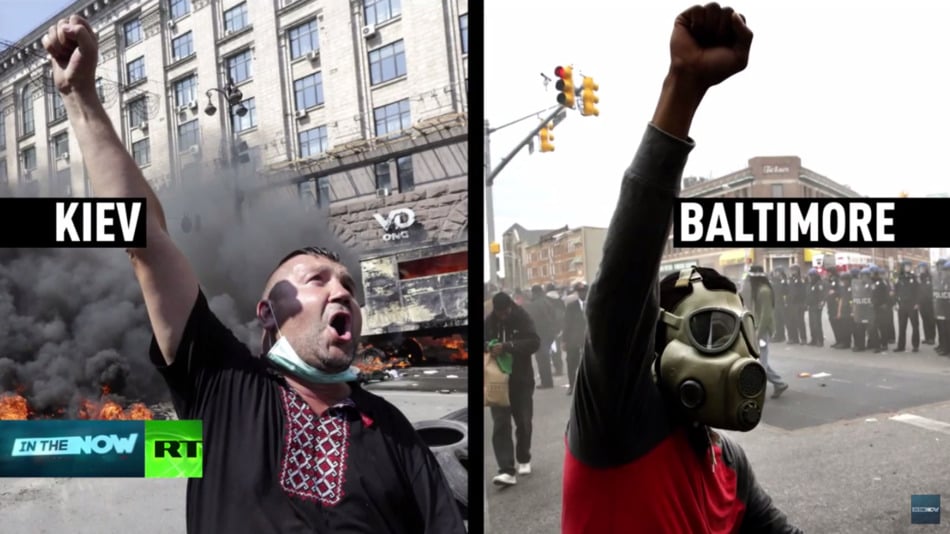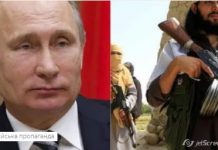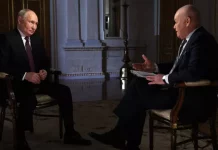
As the world watched TV screens and Twitter streams showing Baltimore in chaos, Russia’s propaganda machine got to work exploiting the unrest with what is known locally as “whataboutism.”
In the Soviet era, any criticism of the Motherland — such human rights violations or censorship — was met with a “what about…” in an attempt to redirect attention away from Moscow.
Baltimore’s protests were used in the Russian media as a comparison with the situation in Ukraine, where protesters in February 2014 ousted the country’s Moscow-leaning president, Viktor Yanukovych, after three months of deadly clashes with security forces.
For the Kremlin, unrest in the U.S. — starting with Ferguson last year — is a opportunity to heave mud at Washington for its support of Ukraine’s pro-Western Maidan protests, which have raised East-West tensions to a level not seen since the Cold War.
When violence erupted on Baltimore’s streets this week, Russia’s state media saw another opportunity.
“Colored Revolution: ‘Afromaidan’ awaits for America,” read the headline of a story from Russia’s state-run Vesti 24 TV channel, alluding to both the racial aspects of the Baltimore protests and the so-called color revolutions in post-Soviet countries, the ones that overthrew pro-Russian governments in the years following the collapse of the USSR.
Pro-Russia Twitter users also set about making the Kiev-Baltimore comparison. An account named Afromaidan juxtaposed images from the two cities with quotes from President Obama on the separate events.
#Балтимор #Baltimore #Афромайдан #Afromaydan #Чернороссия #США #Украина #майдан pic.twitter.com/Fui55pCyyZ
— АФРОМАЙДАН (@Afromaydan) April 29, 2015
“We strongly advise everyone to respect the right to peaceful protest in Ukraine,” reads an Obama quote from the 2014 Ukrainian revolution. Another, from yesterday’s joint press conference with the Japanese prime minister, reads: “Marauders in Baltimore must be considered criminals. The violence had nothing to do with peaceful protests.”
Anissa Naouai, host of RT’s “In The Now” program, joined in Tuesday. “Rioting and looting is wrong, it’s violent, destructive and illegal. And there’s no doubt Baltimore rioted. But who decides what qualifies as a riot?” Naouai asks her viewers. “The media? The government? Or something else?”
The show then cut to clips from riots in the UK in 2011, and the French riots in 2007. Everyone agreed on those, Naouai said. “But this was not labeled a riot,” she adds as the camera jumps to a video montage from Kiev in winter 2014, showing Ukrainian protesters clashing with security forces.
“Maidan versus Maryland,” Naouai says. “Don’t let the media decide. Not even us. You can see for yourselves. The similarities — well, they speak for themselves.”
Images from both events were then displayed side-by-side.

A Ukrainian man donning a traditional embroidered shirt is contrasted with a Baltimore man wearing a gas mask pump their fists in the air. Raging flames and smoke, the silhouette of an Ukrainian protester waving a flag is shown with a Baltimore fireman atop a ladder, in two images spliced together.
What Naouai and “In The Now” failed to show were the dozens of instances in which Ukrainian police forces — under orders from Yanukovych — brutally attacked peaceful demonstrators. More than 100 people were killed by police during Maidan. Several police also died.
The program also did not mention that it was police who first assaulted protesters in Kiev overnight on Nov. 30, 2013, kicking off the period of unrest. In nearly 10 minutes of video, the program does not show one instance in which police in Kiev attack protesters.
Moreover, in three months of organized protests on Kiev’s Maidan — and in Maidans around the country — there was virtually no looting. Rather, businesses opened their doors to the protesters, providing shelter and aid. McDonald’s even offered counselors to protesters.
Tuesday’s “In The Now” can be seen in its entirety here:
By Christopher Miller, Mashable





